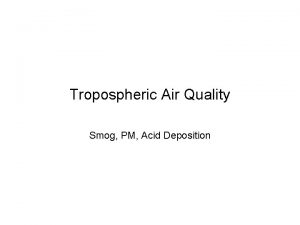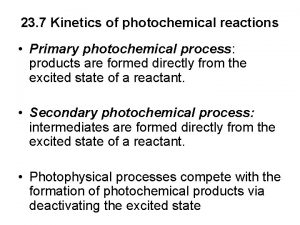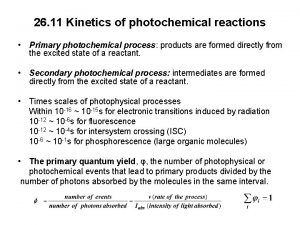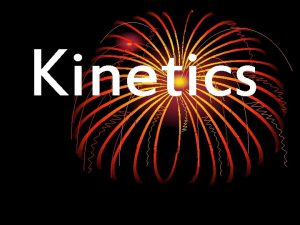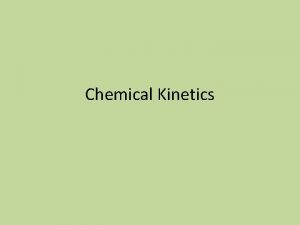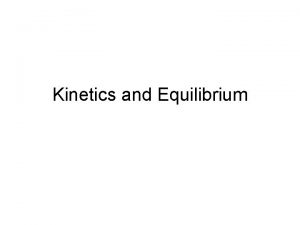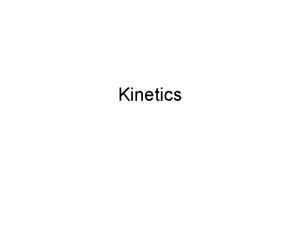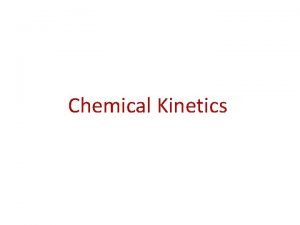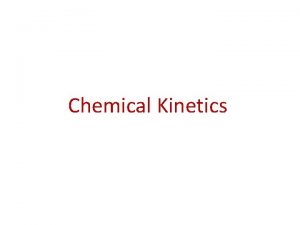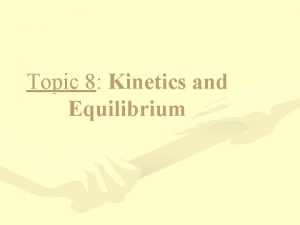23 7 Kinetics of photochemical reactions Primary photochemical











- Slides: 11

23. 7 Kinetics of photochemical reactions • Primary photochemical process: products are formed directly from the excited state of a reactant. • Secondary photochemical process: intermediates are formed directly from the excited state of a reactant. • Photophysical processes compete with the formation of photochemical products via deactivating the excited state

• Times scales of photophysical processes Within 10 -16 ~ 10 -15 s for electronic transitions induced by radiation and thus the upper limit for the rate constant of a first order photochemical reaction is about 1016 s-1. 10 -12 ~ 10 -6 s for fluorescence 10 -12 ~ 10 -4 s for intersystem crossing (ISC) 10 -6 ~ 10 -1 s for phosphorescence (large organic molecules) • A slowly decaying excited species can undergo a very large number of collisions with other reactants before deactivation. • The interplay between reaction rates and excited state lifetimes is a very important factor in the determination of the kinetic feasibility of a photochemical process.


• The primary quantum yield, φ, the number of photophysical or photochemical events that lead to primary products divided by the number of photons absorbed by the molecules in the same interval, or the radiation-induced primary events divided by the rate of photo absorption. • The sum of primary quantum yields for all photophysical abd photochemical events must be equal to 1


• From the above relationship, the primary quantum yield may be determined directly from the experimental rates of ALL photophysical and photochemical processes that deactivate the excited state.

Decay mechanism of excited singlet state • Absorption: • Fluorescence: S + hvi → S* S* → S vabs = Iabs + hvi vf = kf[S*] • Internal conversion: S* → S v. IC = k. IC[S*] • Intersystem crossing: S* → T* v. ISC = k. ISC[S*] S* is an excited singlet state, and T* is an excited triplet state. The rate of decay • = - kf[S*] - k. IC[S*] - k. ISC[S*] When the incident light is turn off, the excited state decays exponentially: with

• If the incident light intensity is high and the absorbance of the sample is low, we may invoke the steady-state approximation for [S*]: Iabs - kf[S*] - k. IC[S*] - k. ISC[S*] = 0 Consequently, Iabs = kf[S*] - k. IC[S*] - k. ISC[S*] The expression for the quantum yield of fluorescence becomes: • The above equation can be applied to calculate the fluorescence rate constant.

Quenching • The presence of a quencher, Q, opens an additional channel for deactivation of S* S* + Q → S + Q v. Q = k. Q[Q][S*] Now the steady-state approximation for [S*] gives: Iabs - kf[S*] - k. IC[S*] - k. ISC[S*] - k. Q[Q][S*] = 0 The fluorescence quantum yield in the presence of quencher becomes • The ratio of Φf, 0/ Φf is then given by • Therefore a plot of the left-hand side of the above equation against [Q] should produce a straight line with the slope τ0 k. Q. Such a plot is called Stern-Volmer plot.

• The fluorescence intensity and lifetime are both proportional to the fluorescence quantum yield, plot of If, 0/I 0 and τ0/ τ against [Q] should also be linear with the same slope and intercept as • Self-test 23. 4 The quenching of tryptophan fluorescence by dissolved O 2 gas was monitored by measuring emission lifetimes at 348 nm in aqueous solutions. Determine the quenching rate constant for this process [O 2]/(10 -2 M) 0 2. 3 5. 5 8 10. 8 Tau/(10 -9 s) 2. 6 1. 5 0. 92 0. 71 0. 57

Three common mechanisms for bimolecular quenching 1. Collisional deactivation: S* + Q → S + Q is particularly efficient when Q is a heavy species such as iodide ion. 2. Resonance energy transfer: S* + Q → S + Q* 3. Electron transfer: S* + Q → S+ + Qor S* + Q → S - + Q+
 Unit 5 chemical reactions answers
Unit 5 chemical reactions answers Oxidation half reaction
Oxidation half reaction Section 2 reinforcement classifying chemical reactions
Section 2 reinforcement classifying chemical reactions Types of reactions
Types of reactions Section 2 classifying chemical reactions
Section 2 classifying chemical reactions Effects of photochemical smog
Effects of photochemical smog Smog
Smog State stark einstein law
State stark einstein law Define quantum yield of a photochemical reaction
Define quantum yield of a photochemical reaction Kinetics ap chemistry
Kinetics ap chemistry Types of reactions grade 11
Types of reactions grade 11 Vampnets for deep learning of molecular kinetics
Vampnets for deep learning of molecular kinetics






